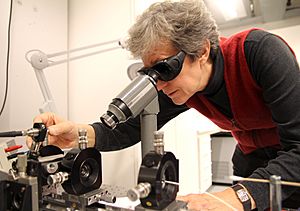Ursula Gibson facts for kids
Quick facts for kids
Ursula J. Gibson
|
|
|---|---|
| Alma mater | Dartmouth College Cornell University |
| Scientific career | |
| Institutions | Clemson University Kungliga Tekniska Högskolan Norwegian University of Science and Technology Dartmouth College University of Arizona |
| Thesis | Optical and Structural Properties of Thin Film Composites (1982) |
Ursula J. Gibson is an American scientist who studies materials. She is known for her work on new types of optical fibers. These are tiny strands of glass or plastic that carry light.
Contents
Early Life and School
Ursula Gibson was born in Sheffield, England. She moved to the United States in the 1960s. She lived in Philadelphia and then in Ithaca, New York.
She studied physics at Dartmouth College. Later, she earned her master's and Ph.D. degrees from Cornell University. This was in 1978 and 1982. Her Ph.D. research looked at thin film composites. During her studies, she also worked at Bell Labs for two summers.
Her Work and Discoveries
After getting her Ph.D., Dr. Gibson became a professor. She worked at the Optical Sciences Center at the University of Arizona. In 1990, she went back to Dartmouth College. There, she taught about materials science and nanotechnology. She also worked with chemists and biologists.
In 2010, Dr. Gibson joined the Norwegian University of Science and Technology (NTNU). She was elected to the International Commission on Optics Bureau in 2011. She also served as the president of Optica in 2019. She retired from NTNU and KTH Royal Institute of Technology in 2021. Today, she is a professor at Clemson University and emerita at Dartmouth College.
Research on Optical Materials
Dr. Gibson's research has explored many optical materials. These include polymers, protein crystals, and semiconductors. She focuses on very small structures. Examples are thin films and waveguides. She has four patents and has written seven book chapters.
Her current work focuses on optical fibers. These fibers have cores made from semiconductors. Semiconductors are materials that can conduct electricity. These special fibers have unique properties. They can be used to make solar cells.
Making Special Fibers
Dr. Gibson develops optical fibers with cores. These cores are made from Group IV and III-V semiconductors. These materials have special properties. They can change light and electricity. They can also be made in large amounts.
The fibers are very thin and long. This allows them to be heated with lasers. The laser heat helps the semiconductor material to recrystallize. This means the material forms a single crystal. A single crystal is best for carrying light. It also makes the fiber stronger.
Dr. Gibson used laser treatment to create structures. She made areas of germanium-rich material. These were inside crystalline silicon-germanium core fibers. Fast cooling helps the mixture form a single crystal. This is great for sending light. It also makes the fibers very strong.
With physicist Zahra Ghadyani, Dr. Gibson started a company called NorFib. This company aims to use these special fibers. They want to create a system for making electricity from solar energy.
Awards and Recognitions
Dr. Gibson has received many awards for her work:
- 1997 NASA/American Society for Engineering Education Visiting Research Fellow
- 2001 National Academy of Engineering Frontiers in Engineering
- 2004 NASA Network of Educator Astronaut Teachers
- 2008 Fulbright Fellow in Finland
- 2018 Fellow of Optica
- 2019 President of Optica
In 2017, she was chosen for Academia Net. This is a network of top female scientists.
Personal Life
Dr. Gibson is married to Ulf Lennart Österberg. He was also a professor at the Thayer School of Engineering. They have three children.


